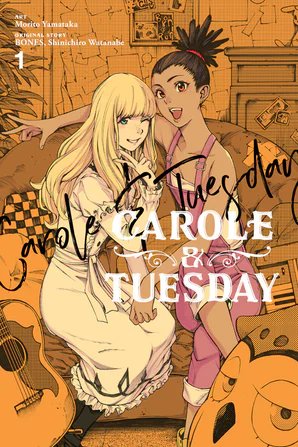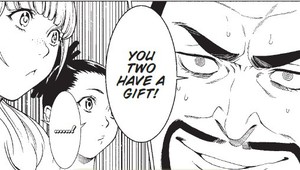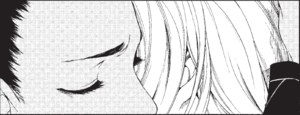The Fall 2020 Manga Guide
Carole & Tuesday
What's It About?
 Fifty years have passed since mankind began migrating to the new frontier: Mars. It's an age where most culture is produced by AI, and people are content to be passive consumers. There's a girl scraping a living in the metropolis of Alba City, she's working part-time while trying to become a musician. She's always felt like something is missing. Her name is Carole. There's another girl. Born to a wealthy family in the provincial town of Herschel City, she dreams of becoming a musician, but nobody around her understands. She feels like the loneliest person in the world. Her name is Tuesday. A chance meeting brings them together. (from anime)
Fifty years have passed since mankind began migrating to the new frontier: Mars. It's an age where most culture is produced by AI, and people are content to be passive consumers. There's a girl scraping a living in the metropolis of Alba City, she's working part-time while trying to become a musician. She's always felt like something is missing. Her name is Carole. There's another girl. Born to a wealthy family in the provincial town of Herschel City, she dreams of becoming a musician, but nobody around her understands. She feels like the loneliest person in the world. Her name is Tuesday. A chance meeting brings them together. (from anime)The Carole & Tuesday manga is drawn by Morito Yamataka and adapts the BONES/Shinichirō Watanabe anime of the same name. Yen Press will release the print version of its first volume on December 15 for $13.00
Is It Worth Reading?

Rebecca Silverman
Rating:
Of all of the things to express in a soundless medium, I've often thought that music is the most difficult. In the case of Carole & Tuesday, that may in part be due to the fact that I haven't seen the source anime, so I don't have any sounds in my head that go with it. But I do have an older cousin who was a big Cyndi Lauper fan (and fondness for the very dumb Cyndi Lauper/Jeff Goldblum movie “Vibes” from the 80s), and this manga does capture some of what I always got from Lauper's music when I was little – a sense of bright colors, fun, and the idea that it doesn't matter what you do as long as you love it.
If Carole & Tuesday's first volume has a major strength, it's that. Both girls are bound and determined to make something of themselves, preferably with music, and when they stumble across each other just after Tuesday's arrival in the big city, something just clicks. That's a moment that's well captured, too, because sometimes you just immediately hit it off with someone, like the friend version of the insta-love trope. (Not that this won't turn into romantic love, but I'm seeing best friends here at the moment.) They both find something beyond music that they've been looking for in each other, which is also interesting because Tuesday's never really been alone and Carole always has, although Tuesday's family life certainly doesn't seem to have been a happy one. But maybe they were both missing partners, and that's something that they truly are within probably hours of meeting each other, which, again, is a major plus.
The pacing here doesn't work quite as well as the characters' relationship, unfortunately. It feels very rushed, starting with when the girls are secretly recorded and uploaded online, where they promptly go viral. (How are the same social networks being used far enough into the future that there's a healthy colony on Mars? That feels off to me.) At that point it feels like someone hit the fast-forward button and things just start happening way too quickly. They're viral! They've reformed the drunk curmudgeon! Who's a music producer! And he wants to produce them! And they meet a pop star! And perform at a major festival! Wow! It doesn't quite give us the time we need (or want, in my case) to see the girls develop their relationship further. It isn't bad, but it really could have been done better.
That's what keeps this from being a great volume instead of a good one. It has all of the elements it needs to tell its story, but it isn't using them as wisely as it could. Perhaps it's just trying to get to a certain point in the anime's plot, I don't know. But it is still almost as much fun as Cyndi Lauper's album “She's So Unusual” and a whole lot less corny than “Vibes,” and for a book with two whole chapters referencing Lauper, that's pretty good.

Caitlin Moore
Rating:
Carole & Tuesday was, without a doubt, one of the best anime of 2019. Although the ending was a bit soppy and idealistic, its gorgeous direction, beautifully composed music, and tale of connection, collaboration, and friendship between two girls with seemingly nothing in common made their mark. A lot of what made it so special doesn't transfer easily to a two-volume manga, however, but could the elements that do so carry it through?
The answer, it would seem, is, “Ehhhh…” with a waggling hand motion.
I've been wracking my brain trying to think of what they were hoping to achieve with this. A way to bring the story to people who can't watch the anime or prefer manga? I don't want to think it's just a cash grab or a way to advertise the anime in a popular seinen magazine. Because, as you know, I'm an optimist. (Hey, quit laughing!)
The story is almost shot-for-shot identical to the anime for the first half of the volume, minus Angela, who only gets introduced in the last panel of the volume. It then jumps straight to them performing at the music festival, without any of the intermediate steps. What was a risky move in the anime, done so because they've exhausted all their other alternatives, feels straight-up cruel in the manga because the two have barely started collaborating. While the original did have pacing issues at times, this is much too abrupt. Plus, without the charming musical sequences with the girls' clear vocals, it's hard to understand the chemistry that makes them so special.
But there are advantages and disadvantages to every medium, and this being a manga rather than an anime does bring a few new elements to the table. Characters get internal monologues that I don't recall being in the anime that give new insight into their motivations, and some of the page compositions are cool and interestingly done. Still, these pale in comparison to what's lost in translation from screen to page.
discuss this in the forum (29 posts) |
back to The Fall 2020 Manga Guide
Feature homepage / archives